
Blunt behavior
 In addition to their reputation for ruining everything from homeownership to the diamond market, millennials are often accused of having pretty poor manners. From the way they respond to phone calls and emails (and occasionally text messages) to their body language and table etiquette, you might get the impression that young people today are nothing short of rude. As it turns out, most millennials have the same feelings toward basic decency as older generations—and that includes when it comes to their cellphones. Over 99 percent of people said being on your phone while in a face-to-face conversation was the rudest personal behavior. And while baby boomers (100 percent) had the lowest opinion of this action, Gen Xers (96 percent) and millennials (99 percent) weren’t far behind. Of course, it’s possible to know spending too much time looking at your phone is rude yet still be unable to resist all the same. The average person spends almost three hours a day looking at their phone, and health experts say those bad habits can quickly form into addictive behaviors if people aren’t careful. Using your phone in a movie theater (nearly 99 percent), texting during a face-to-face conversation (about 98 percent), and using your speakerphone in public (roughly 97 percent) were all ranked by young and old alike as more disrespectful than eating before others had their food, talking politics at the dinner table, and leaving a gathering early.
In addition to their reputation for ruining everything from homeownership to the diamond market, millennials are often accused of having pretty poor manners. From the way they respond to phone calls and emails (and occasionally text messages) to their body language and table etiquette, you might get the impression that young people today are nothing short of rude. As it turns out, most millennials have the same feelings toward basic decency as older generations—and that includes when it comes to their cellphones. Over 99 percent of people said being on your phone while in a face-to-face conversation was the rudest personal behavior. And while baby boomers (100 percent) had the lowest opinion of this action, Gen Xers (96 percent) and millennials (99 percent) weren’t far behind. Of course, it’s possible to know spending too much time looking at your phone is rude yet still be unable to resist all the same. The average person spends almost three hours a day looking at their phone, and health experts say those bad habits can quickly form into addictive behaviors if people aren’t careful. Using your phone in a movie theater (nearly 99 percent), texting during a face-to-face conversation (about 98 percent), and using your speakerphone in public (roughly 97 percent) were all ranked by young and old alike as more disrespectful than eating before others had their food, talking politics at the dinner table, and leaving a gathering early.
Gendered expectations
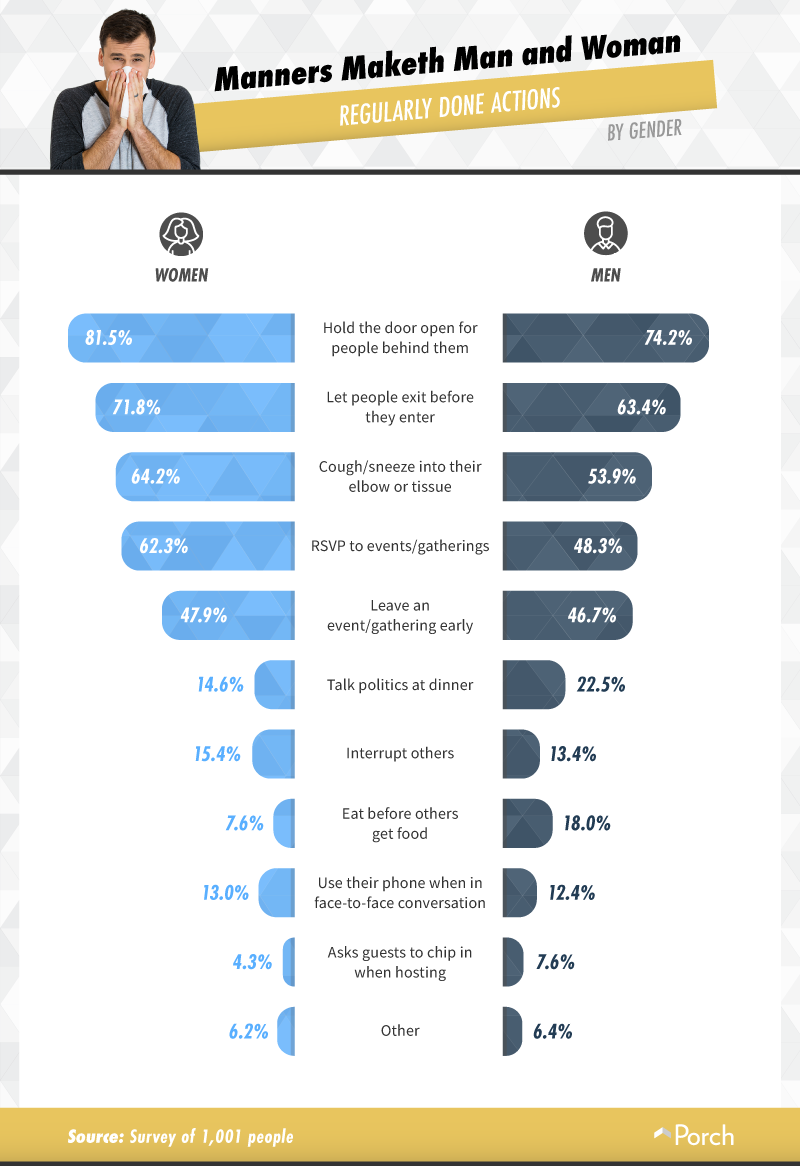 Knowing that certain behaviors might be largely regarded as rude is one thing, but making a conscious effort to do the right thing is something else entirely. When asked about their everyday actions, women were the fairer sex when it came to their well-mannered habits. Women were more likely than men to hold the door open for people coming in behind them (almost 82 percent), let others exit before trying to enter (around 72 percent), and cough into their elbow or a tissue (64 percent). And while men were generally less acquainted with these good-mannered behaviors, they were slightly less likely to interrupt others, leave a party or event early, or use their phones in face-to-face conversations.
Knowing that certain behaviors might be largely regarded as rude is one thing, but making a conscious effort to do the right thing is something else entirely. When asked about their everyday actions, women were the fairer sex when it came to their well-mannered habits. Women were more likely than men to hold the door open for people coming in behind them (almost 82 percent), let others exit before trying to enter (around 72 percent), and cough into their elbow or a tissue (64 percent). And while men were generally less acquainted with these good-mannered behaviors, they were slightly less likely to interrupt others, leave a party or event early, or use their phones in face-to-face conversations.
Turning sentiment into action
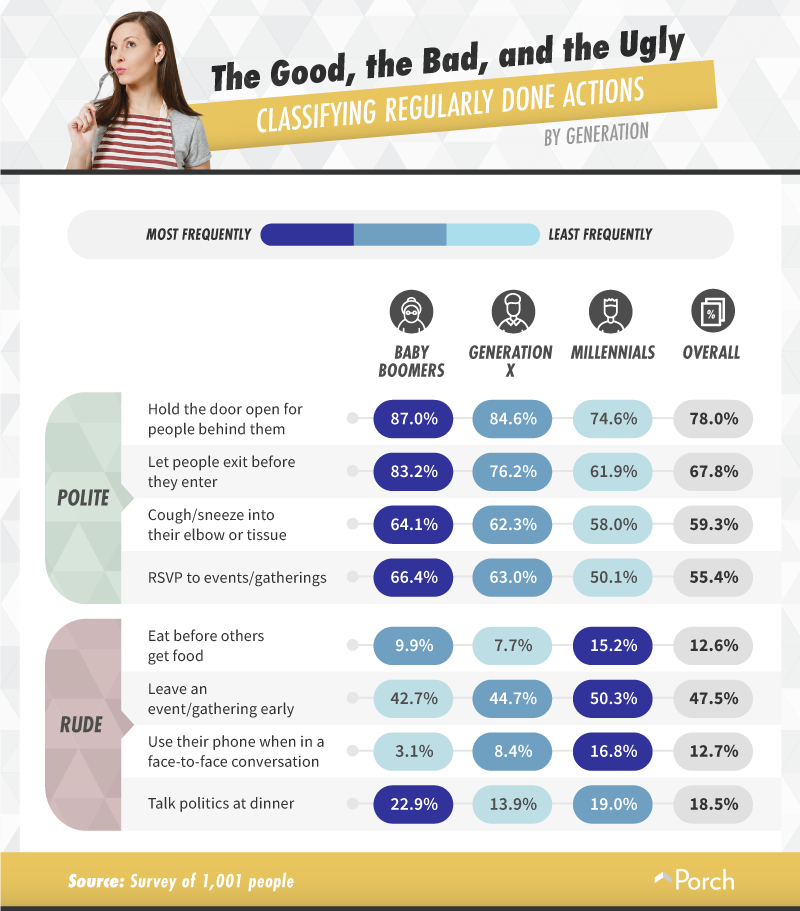 There’s no denying that even interactions with people you love may feel a bit more blunt or impolite than what you may have seen on family sitcoms. Maybe it’s reality TV convincing us that it’s OK to yell at people (even people we like) or just a general shift in civility, but certain “good” behaviors may be fading away with older generations. When asked about their routine actions, millennials were the least likely generation to admit to holding the door open for people behind them, letting people exit before they entered, RSVPing to events, or sneezing into their elbows or a tissue. Unfortunately for young people, the narrative of their rudeness doesn’t end there. Based on their own responses, millennials were also the mostlikely generation to leave an event early, eat before everyone else had their food, and to use their phones during face-to-face conversations. The only “rude” behavior baby boomers did more often than the other generations? Talking politics at the dinner table.
There’s no denying that even interactions with people you love may feel a bit more blunt or impolite than what you may have seen on family sitcoms. Maybe it’s reality TV convincing us that it’s OK to yell at people (even people we like) or just a general shift in civility, but certain “good” behaviors may be fading away with older generations. When asked about their routine actions, millennials were the least likely generation to admit to holding the door open for people behind them, letting people exit before they entered, RSVPing to events, or sneezing into their elbows or a tissue. Unfortunately for young people, the narrative of their rudeness doesn’t end there. Based on their own responses, millennials were also the mostlikely generation to leave an event early, eat before everyone else had their food, and to use their phones during face-to-face conversations. The only “rude” behavior baby boomers did more often than the other generations? Talking politics at the dinner table.
High standards
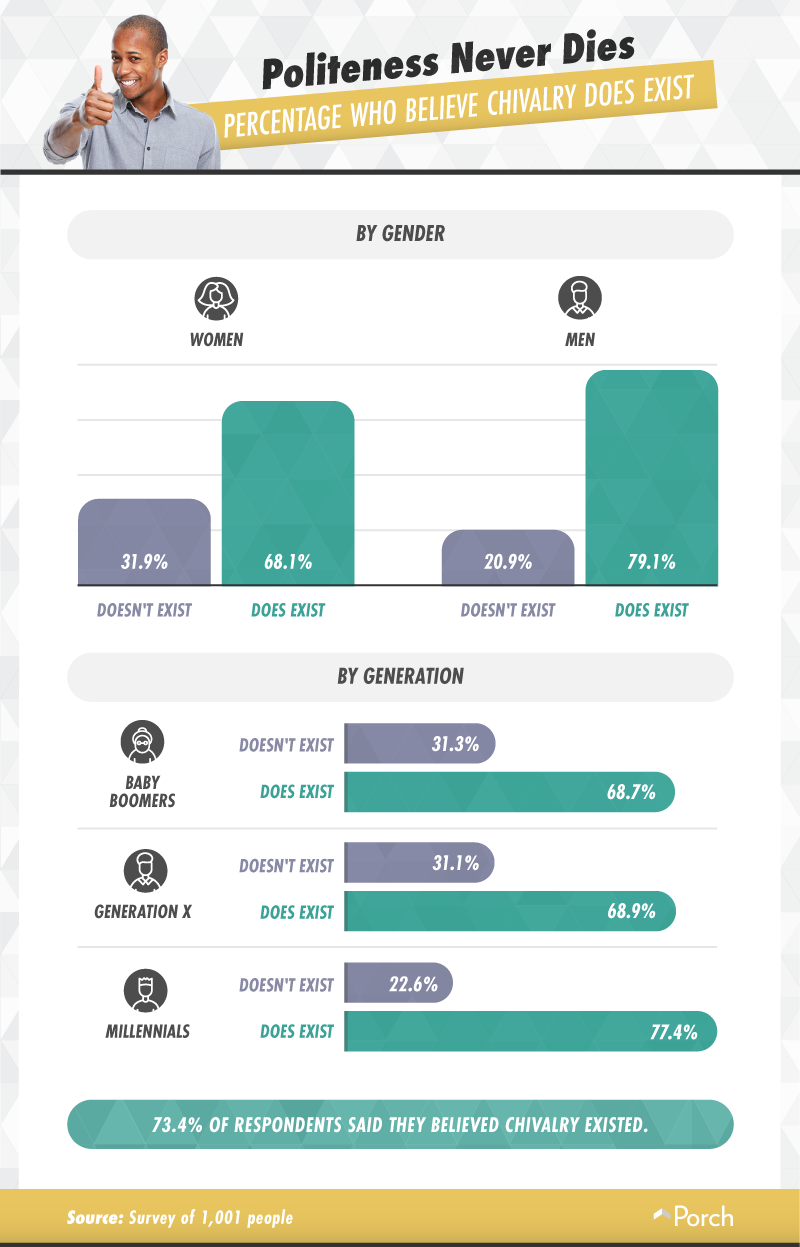 If you’ve ever heard someone bitterly mumble that “chivalry is dead,” you might at least wonder how a 12th-century term for European feudal systems continues to turn up as a modern-day characterization of what it means to be kind or decent. Even if the words are rooted in a different meaning, most men and women had their own take on its definition. According to our survey, roughly 1 in 5 men and less than 1 in 3 women were of the opinion that chivalry was dead, although this slightly pessimistic perspective was more common among older generations that millennials.
If you’ve ever heard someone bitterly mumble that “chivalry is dead,” you might at least wonder how a 12th-century term for European feudal systems continues to turn up as a modern-day characterization of what it means to be kind or decent. Even if the words are rooted in a different meaning, most men and women had their own take on its definition. According to our survey, roughly 1 in 5 men and less than 1 in 3 women were of the opinion that chivalry was dead, although this slightly pessimistic perspective was more common among older generations that millennials.
Picking up the check
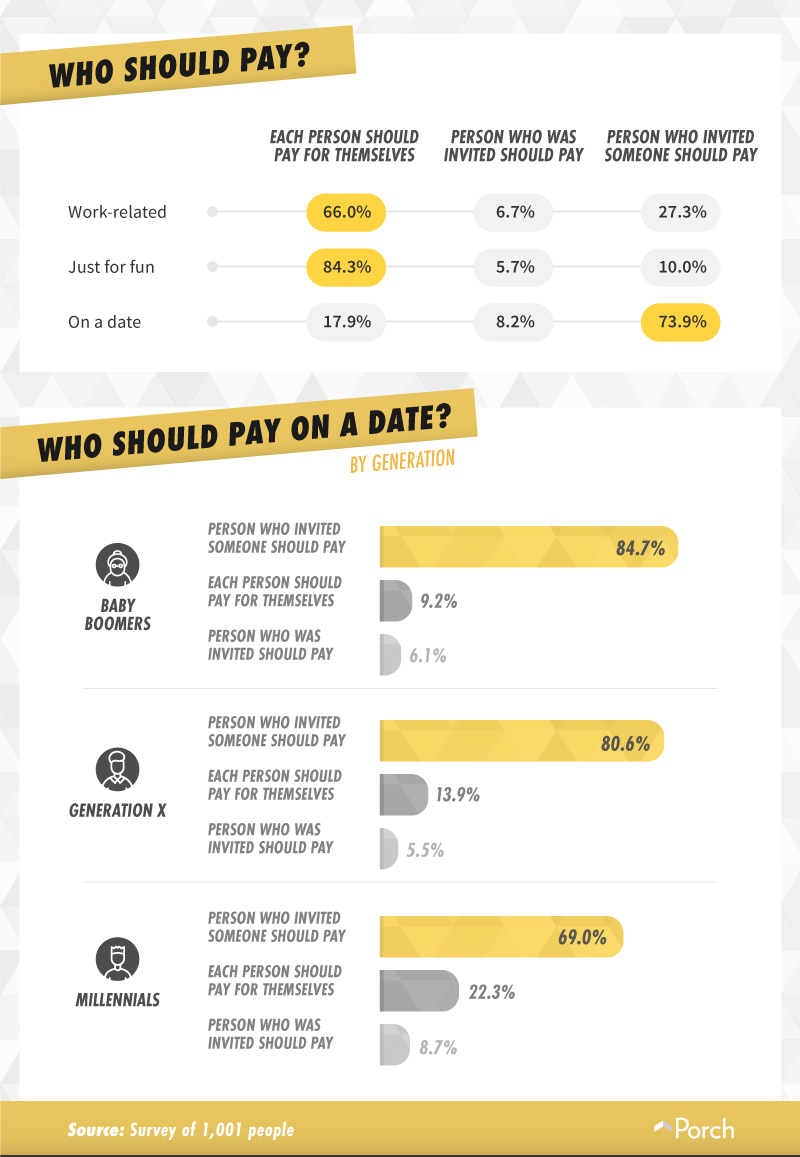 The idea of what it means to be chivalrous (particularly in a romantic sense) has changed. Rather than designating a particular gender as the responsible party for picking up the tab on a date, nearly 74 percent of people agreed the inviting party should be responsible for paying. Less than 1 in 5 people might even suggest each person should pay for himself or herself. In most cases, who pays for the first date isn’t as much about chivalry as it is about setting the tone for boundaries and expectations in a relationship.
The idea of what it means to be chivalrous (particularly in a romantic sense) has changed. Rather than designating a particular gender as the responsible party for picking up the tab on a date, nearly 74 percent of people agreed the inviting party should be responsible for paying. Less than 1 in 5 people might even suggest each person should pay for himself or herself. In most cases, who pays for the first date isn’t as much about chivalry as it is about setting the tone for boundaries and expectations in a relationship.
An outside perspective
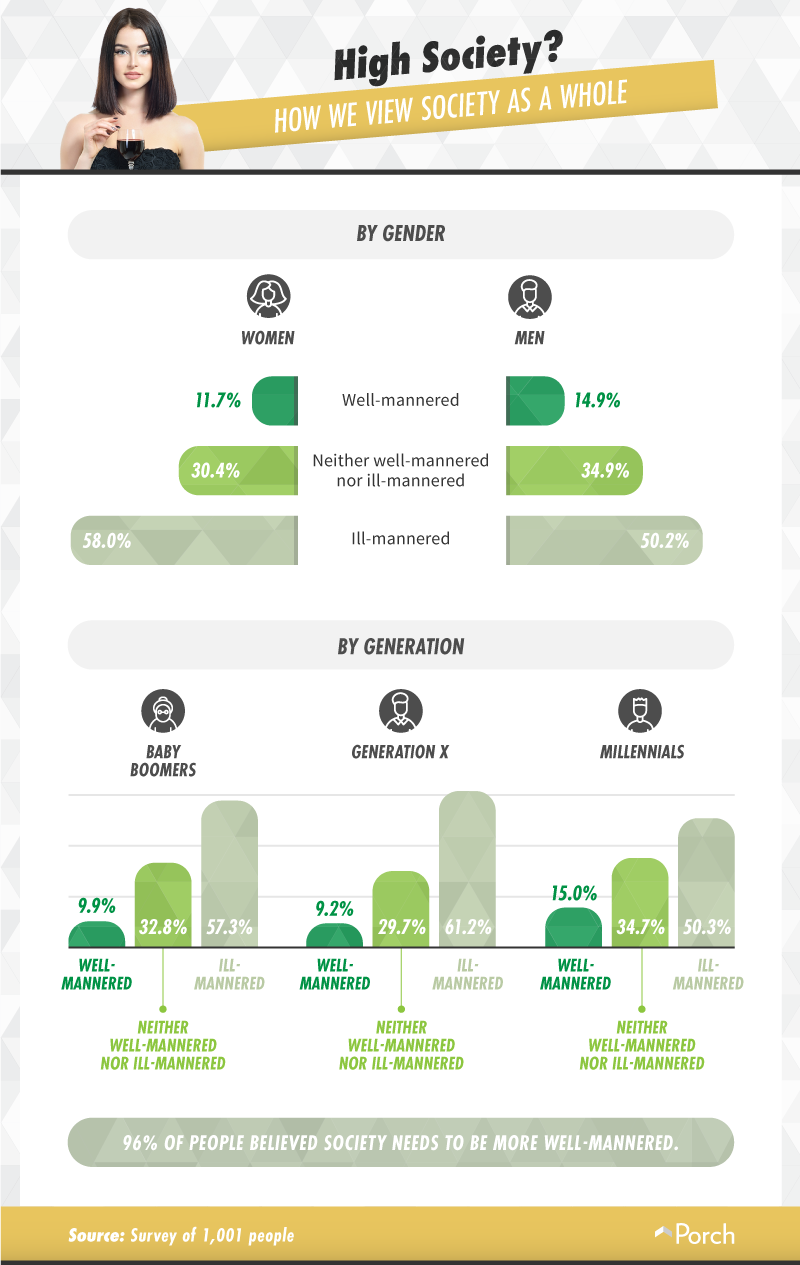 When asked to rate the behavior of society as a whole, men were more inclined than women to identify other people as being “well-mannered.” While roughly 1 in 3 survey participants agreed people were neither well- nor ill-mannered, more than half ultimately rated society as having rude tendencies and bad behavior. Moreover, that low opinion was especially reserved for Gen Xers.
When asked to rate the behavior of society as a whole, men were more inclined than women to identify other people as being “well-mannered.” While roughly 1 in 3 survey participants agreed people were neither well- nor ill-mannered, more than half ultimately rated society as having rude tendencies and bad behavior. Moreover, that low opinion was especially reserved for Gen Xers.
Modern civility
Most people, regardless of age, agree on some of the most ill-mannered actions. But knowing something is in bad taste and actually adjusting our behavior to be more respectful isn’t always the same. Even though millennials agreed on what classified as bad manners, they were the most likely to do those actions. At Porch, we’ll make sure no one ever wants to leave your party early and talk politics at the dinner table. No matter what handyman projects are piling up on your to-do list, we’ve got you covered. With the Porch Home Assistant, we’ll match you with one of our certified team professionals for the best hassle-free help, no matter what job needs to get done. From installing new appliances to cleaning out the gutters or mounting a new TV—Porch has your back. Visit us at Porch to learn more.
Methodology and Limitations
For the information presented in this project, we utilized the Mechanical Turk service provided by Amazon to survey 1,001 people of varying demographic backgrounds. Of our respondents, 514 identified as women, 484 identified as men, and three identified as neither. As with any survey, these results are based on self-reported data, and the answers are based on the opinion of the respondents.
Sources
- https://www.countryliving.com/life/a38748/good-manners/
- https://www.elitedaily.com/life/rude-af-things-millennials/1492308
- https://www.health.com/anxiety/cell-phone-addiction
- https://www.thespruce.com/graciously-deal-with-rude-people-1216923
- https://www.history.com/news/how-chivalry-died-again-and-again
Fair Use Statement
Love the story we’ve put together? It’s rude not to share, so feel free to repost the findings from our survey on your own site for any noncommercial use. Be kind and include a link back to this page so that our contributors get credit for their work too.
